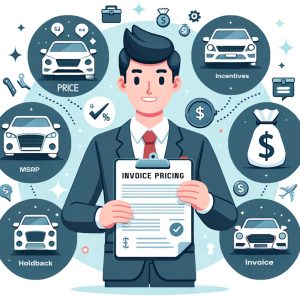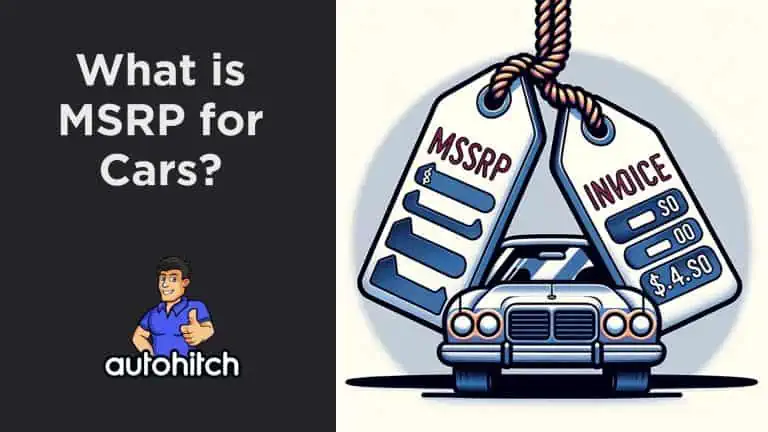When shopping for a new car, you’ll inevitably come across the term MSRP. But what exactly does it mean and how does it factor into negotiating the final price you pay?
This complete guide breaks down everything you need to know about MSRP and other key pricing terminology.
Related Articles To Read:
- Window Sticker By Vin Free – How To
- How Much Are Dealer Fees and How to Avoid Them
- How Much Do Dealerships Make on New Cars
- How Much Do Dealers Markup Used Cars
- How Much Will Dealers Come Down on a Used Car?
Table of Contents
What MSRP Stands For
MSRP stands for the manufacturer’s suggested retail price. It is the recommended sales price set by car manufacturers for their vehicles. Dealers display a car’s MSRP on the Monroney sticker or window sticker.
While the MSRP sets a reference point, dealers can ultimately charge higher or lower prices. If a car is in high demand, the dealer may add a market adjustment above MSRP. For slower selling models, they may discount below MSRP to spur sales.

What is the Sticker Price of a Car?
The sticker price refers to the total vehicle price displayed on the Monroney sticker (also called window sticker) attached to new cars.
It contains:
- Base Manufacturer’s Suggested Retail Price (MSRP): The minimum MSRP set by automakers before additions.
- Added options and packages installed by the dealer
- Destination and transportation fees levied by manufacturers
- Dealer preparation fees
The sticker price sets the baseline for negotiations. It does not include taxes, registration costs, or dealer-added items like extended warranties.
With high-demand models, paying a full sticker price or above is common.
Understanding the Difference Between MSRP and Invoice Price
The MSRP should not be confused with the invoice price, which is what the dealer paid the manufacturer to obtain the vehicle.
Comparing the MSRP versus the invoice price is a key part of negotiating the best deal possible on a new car.
How Much Below MSRP is Dealer Invoice?
On average, the invoice price is 2-5% less than MSRP. But this markup varies by vehicle:
- Luxury models tend to have more wiggle room between MSRP and invoice price.
- High-demand vehicles also often have a larger difference between MSRP and invoice.
- More common, less in-demand models may have only a small markup from invoice to MSRP.
Knowing how much dealerships make on a new car gives you more negotiating leverage.
How Options, Fees, and Taxes Raise the Price Above Base MSRP
Along with the options you choose, there are additional fees that push the final price over base MSRP:
| Fee | Typical Cost |
|---|---|
| Destination charge | $800-$1,400 |
| Documentation fee | $75-$500 |
| Taxes | Varies by location |
| Title, registration, plate fees | Varies by location |
This is why out-the-door pricing ends up higher than just MSRP. Our handy car fees calculator can estimate these costs.
MSRP Pricing Factors: What Impacts a Car’s Suggested Retail Price
What determines a vehicle’s initial MSRP in the first place? Key factors include:
- Base price: The starting MSRP for that model’s most basic trim level.
- Market demand: Models in high demand have less incentive to discount MSRP.
- Options and packages: Additional equipment raises MSRP. These can add hundreds to thousands in costs.
- Luxury status: Premium brands command higher profit margins, leading to increased MSRP pricing.
- Materials and production: More expensive materials, limited runs, and hand craftsmanship raise prices.
- Brand value: Perceived prestige allows luxury marques to set higher prices.
- Segment pricing: To stay competitive, brands price according to broader segment trends.
Understanding these gives you insight into why pricing varies model to model.
Can You Negotiate Below the Car’s MSRP?
The good news is you aren’t required to pay the full MSRP price. However, how much room you have for negotiating down depends on market factors:
| Market Factor | Negotiation Impact |
|---|---|
| High demand, low supply | Little wiggle room if inventory is limited. |
| Common model, ample inventory | More flexibility if the dealer is motivated to move units. |
| Incentives available | Manufacturers lower prices with rebates and financing deals. |
| Model year changeover | Previous year models see discounts as new model year arrives. |
| Special edition vehicle | Limited runs mean less discounting. |
| Highly optioned vehicle | More margin if starting with a higher MSRP. |
| Model redesign | Prior generation sees greater discounts before redesign. |
Doing research on pricing and checking multiple dealers gives you more leverage when it’s time to negotiate. While paying under invoice price is rare, a price between invoice and MSRP is often achievable.
Helpful Tips for Negotiating Your Best Deal

Follow these tips when negotiating below MSRP:
- Research fair market value prices to establish a reasonable target range.
- Get MSRP and invoice pricing upfront to determine markup.
- Negotiate final out-the-door price including fees, not just vehicle price.
- Be ready to walk away if you can’t get close to the expected price range.
- Avoid talking monthly payment, focus on total purchase price.
- Have financing pre-approved so you can concentrate on vehicle price.
- Check rates and prices online to leverage against dealers.
Is it Illegal For Dealerships to Charge Over MSRP?
No, it is not illegal for car dealers to charge over MSRP.
Dealers are free to set their own prices, as long as they do not engage in deceptive, anti-competitive, or discriminatory pricing practices.
While manufacturers can suggest retail prices, the law allows dealers to charge more if they choose to do so.
My Final Thoughts
The MSRP is intended to streamline pricing, but the negotiation process still holds power. With the right preparation, knowledge, and patience, you can negotiate below MSRP and into the invoice price range for the best possible deal.




